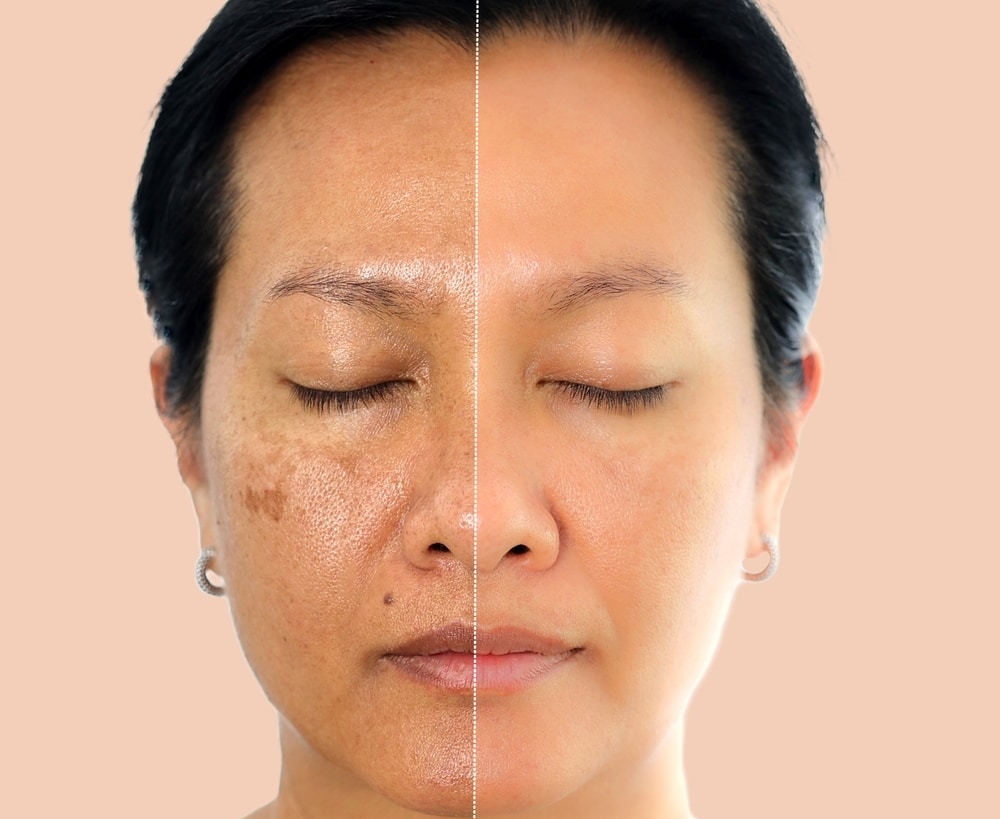Spending time in the sun is inevitable. Between going to family sporting events, relaxing at the beach, and hiking on weekend mornings, you're bound to get a little sun exposure.
All things considered, there's no escaping life in the sun—and cumulative sun exposure often adds up to sun damage. That might leave you wondering: Can you reverse sun damage on your skin, or is it permanent? And how can you prevent it from happening in the first place?
What Is Sun Damage?
Sun damage (also known as photoaging) happens when unprotected skin is exposed to ultraviolet (UV) light, which can damage skin cells and their DNA. Most UV damage comes from the sun, but you can also get it from tanning beds.
In the short term, sun damage manifests as a sunburn or tan. (Yes, a tan counts as damage.) Over time, sun damage adds up, and it can lead to skin cancer and signs of premature aging. Visible signs of sun damage include fine lines and wrinkles, hyperpigmentation, redness, sunspots, roughness, and loose, crepey skin.
How Do Dermatologists Identify Sun Damage?
Dermatologists rely on their in-depth clinical knowledge and training to identify sun damage through a skin examination. They may also use tools to assess the extent of sun damage on the skin. As you might've seen on social media, Derms can use UV photography or light scopes to reveal sun damage. This involves shining a special UV light on the subject, which is either absorbed by sun-damaged skin or reflected at the viewer. The resulting image accentuates color variations—evidence of damage invisible to the naked eye.
Can You Reverse Sun Damage?
You can't reverse sun damage that changes DNA, but you can take steps to repair some damage and improve the appearance of sun-damaged skin. The extent of damage repair possible depends on how much there is. The more damage you have, the harder it'll be to get your skin back to full health. That's why prevention is so important.
How to Repair Sun-Damaged Skin
Whether you're just starting to wonder about sun damage or you've been thinking about it for a while, it's not too late to help repair sun-damaged skin.
Nourish Your Skin Barrier
The first step to getting back on track is repairing skin barrier damage. The skin barrier's main functions are to retain water and protect against external threats. When the skin barrier is damaged, it can't accomplish either of these tasks. The result is dull, compromised skin that's vulnerable to allergens, pollutants, and dehydration. Research shows solar radiation disrupts skin barrier function. This causes damage and weakens the skin's ability to protect itself.
You can repair skin barrier damage with gentle skin care products formulated with the right ingredients. For example, EltaMD Skin Recovery Amino Acid Foaming Cleanser is powered by a blend of amino acids that work together to heal skin, boost skin immunity, and strengthen the skin barrier from within. Calming, soothing, and restorative, it's suitable for all skin types, including sensitive and post-procedure skin.
Other skin care ingredients like Hyaluronic Acid hydrate the skin, which helps support skin barrier function. Make sure to moisturize daily, too.
Protect and Repair Skin with Antioxidants
Too much sun exposure causes oxidative stress, which accelerates cellular damage. This leads to faster, more visible photoaging and increased skin cancer risk. Your skin naturally loses elasticity and firmness over time, but oxidative stress speeds up this process. As a result, your skin may develop wrinkles and fine lines. You might also notice dark spots and a dry, dull-looking complexion.
Antioxidants are your skin's weapon against cellular damage. Look for sunscreens, serums, and moisturizers with antioxidants like Vitamin C and Niacinamide to help prevent skin damage and diminish signs like dark spots.
Shield Skin from Further Sun Damage
While you can't turn back time and reverse sun damage, you can prevent it from accumulating by protecting your skin against sun exposure.
In addition to wearing sun-protective clothing and accessories like hats and sunglasses, apply sunscreen regularly. Choose a broad-spectrum sunscreen with SPF 30 or higher, like EltaMD UV Clear Broad-Spectrum SPF 46, as an everyday source of sun protection.
Remember to seek shade when possible, and see your board-certified Dermatologist regularly (at least for annual checkups).
Consider Professional Treatments
If you have stubborn or extensive sun damage, talk to your Derm. While you can't undo sun damage or skin aging, several cosmetic procedures can improve the visible signs. Treatments like fillers and injectables can plump fine lines, wrinkles, and hollow areas, and laser therapy can reduce the visibility of hyperpigmentation and sunspots. Regular facials may give the skin a noticeable glow, resulting in a more youthful, radiant appearance.
Build Your Foundation of Healthy Skin
You can minimize the effects of harmful UV damage with topical skin care and professional treatments. However, prevention is your best strategy. The good news is that it's never too late to start. No matter where you are on your skin care journey, protecting your skin from the sun will reward you with healthy, vibrant skin that glows from the inside out.

